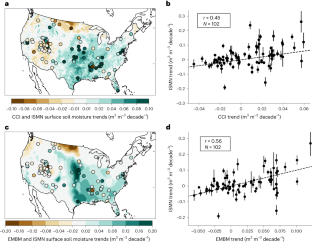2024-02-08 ハーバード大学
<関連情報>
- https://seas.harvard.edu/news/2024/02/temperatures-are-rising-soil-getting-wetter-why
- https://www.nature.com/articles/s44221-024-00193-x
米国の表層土壌水分の過去と将来のトレンドへの寄与を分離する Disentangling contributions to past and future trends in US surface soil moisture
Lucas R. Vargas Zeppetello,Aleyda M. Trevino &Peter Huybers
Nature Water Published:05 February 2024
DOI:https://doi.org/10.1038/s44221-024-00193-x

Abstract
Climate model simulations and various aridity indices generally indicate that summertime surface soil moisture will decrease in the continental USA as a consequence of anthropogenic climate change. However, soil moisture observations from ground probes and satellites from 2011 to 2020 indicate positive summertime trends across 57% of the continental USA. To evaluate the mechanisms driving these trends, we have developed a two-layer land surface model that predicts surface temperature and soil moisture on the basis of observed variations in precipitation, solar radiation, vapour pressure and snowmelt. Of these four model forcings, we found that internal precipitation variability explains the largest fraction of the observed soil moisture trends from 2011 to 2020. Surface air warming and the response of plants to increasing atmospheric CO2 also influence the soil moisture trends, but these effects are small at decadal timescales and partly compensate for one another. Looking forwards, our results indicate that internal precipitation variability will dictate decadal soil moisture trends and that centennial soil moisture trends will primarily depend on changes in precipitation that are currently highly uncertain.



